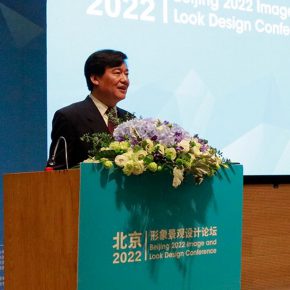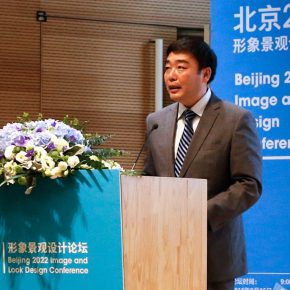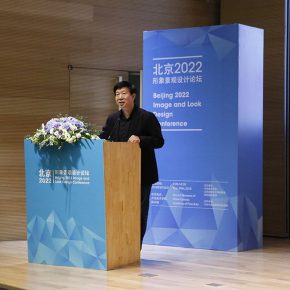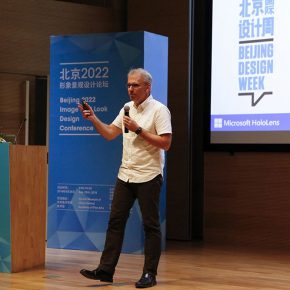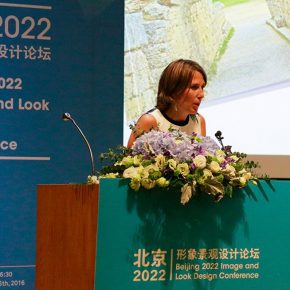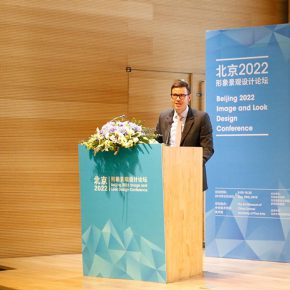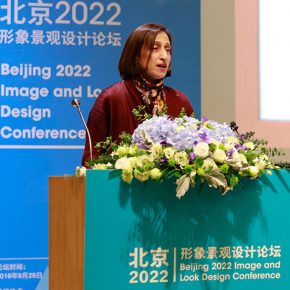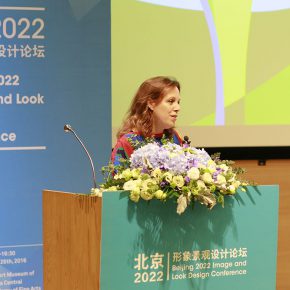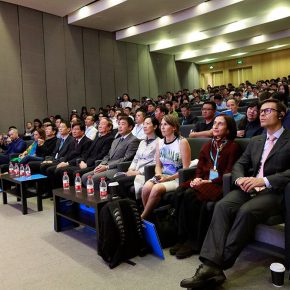
On September 20, 2016, supported by the Propaganda Department of Beijing Winter Olympics Committee, organized by CAFA, in cooperation with the Organizing Committee of Beijing Design Week, Haosi International Group, “Beijing 2022 Image and Look Design Conference” was held in the Auditorium of CAFA Art Museum.
Around the Olympic image design, the forum invited revered guests from all over the world who are associated with the design of Olympic Games to deliver professional keynote speeches, thematic reports, hold special discussions and so on. They were the design officials from IOC, the previous image and design experts, the key design units, institutions and individuals of visual design participating in the previous Olympic Games, as well as technological developers, and so on. Through their own personal experiences they were able to start a multi-dimensional interpretation of the Olympic design process, jointly discussing the visual design of 2022 Beijing Olympic Winter Games.
The whole forum involved 5 aspects: first of all, summarizing and discussing the design achievements and experiences of previous Olympic Winter Games; secondly, exploring the practice and development of contemporary Chinese design culture in the past ten years; thirdly, preparing the prospective visual design of the 2022 Olympic Winter Games; fourthly, promoting the diverse exchange of global design cultures; fifthly, introducing the design and solicitation of the emblems of Beijing 2022 Winter Olympic Games and the Winter Paralympic Games.
Gao Hong, Party Secretary of CAFA, said that, “CAFA has formed its team, mechanism and accumulated experiences in the process of the visual design of the 2008 Beijing Summer Olympic Games, which will lay a solid foundation for the mobilization of all strengths and resources from our school, especially with various talented people participating in the 2022 Winter Olympic Games, while we would like to use this forum and the future cooperation platform to learn from the domestic and foreign artists and institutions.
Jiang Xiaoyu, Executive Vice Chairman of the Organizing Committee of the 29th Olympic Games, who led the visual design of the 2008 Beijing Olympic Games, he believes that it is another historical opportunity for China, to target the world and focus on China, highlighting China again when it finishes the first centenary goal.
Chang Yu, Vice Minister of the Beijing Municipal Committee Propaganda Department and Minister of Press and Propaganda Department of the Organizing Committee for the Beijing Olympic Winter Games, said that the 2022 Olympic Winter Games and the Winter Paralympic Games which would be held in Beijing and Zhangjiakou had an emblem that fully displays Chinese civilization, representing the image of China and the characteristics of the districts of Beijing and Zhangjiakou, thus reflecting the Olympic spirit.
Wang Min, Associate Director of the Academic Committee at CAFA, the doctoral tutor, member of the AGI, and the former artistic director of the image and design of the Organizing Committee of Beijing Olympic Games, shared some experiences of image design in the 2008 Olympic Games. He also introduced the color system and core graphics representing the Chinese culture, as well as the design of Olympic medals with Chinese characteristics.
Bernard Kress, Microsoft Partner, Optical Architect for Holographic Lenses, first mentioned the possibilities of AR and VR being used in the Winter Olympics. Then, he introduced the AR / MR headset.
Marie De Cock, IOC Brand Management, Head of the Business Development, Sustainable Development, said that, “Our brand building starts from the ‘Olympic Charter’ and the Olympic philosophy is a way of life, which integrates mind, body and nature, while the goal of the Olympics is to put sports into the core of the harmonious development of people, sports is a human right, and it is the basis of all our work.”
Cédric Dtwyler, Head of IOC's Image and Design delivered a speech and introduced the main principles of the brand identity and the concept of “Power of One”, as well as the importance of the Olympic appearance and brand identity.
He Jie, Professor from the Academy of Arts and Design, Tsinghua University, the doctoral tutor, former expert of image and design at Beijing Olympic Games, introduced the core graphics for 2008 Beijing Olympic Games and the symbolic meanings, etc.
Theodora Mantzaris, Design/Creative Director of multinational companies including London Dison, Landor, Wolff Olins, the designer of the emblem of Athens 2004 Summer Olympics, compered and introduced some designs of different Olympic Games, such as Munich, Los Angeles, Barcelona, Moscow, Beijing, her design for the Athens 2004 Olympic Games, as well as Salt Lake City, Vancouver, SOCHI Winter Olympics that she had participated in. The features and themes of each games are associated with their nationalities. So that, Beijing 2022 Winter Olympics will also offer quite a unique opportunity to implement new design ideas, implement innovative ideas and stimulate new thinking.
Beth Lula, Brand Director of Rio 2016 Olympics and Paralympic Games, delivered a speech and said that, “We aimed at the Rio 2016 Olympics to make our entire nation proud and it is important to encourage everyone to have a sense of participation. It is necessary to have our own mission, to promote the image of Brazil to the world, and at the same time through sports to promote social and sustainable development of the city, to contribute to the Olympics.”
Lin Cunzhen, Deputy Dean of the School of Design, CAFA, Designer of the logo of Beijing 2022 Winter Olympics, delivered a speech and said that, the original idea was to take Chinese characters as the main body of the logo, because the Chinese language is the world’s largest language system and also the most important element of Chinese culture. To this end they visited Prof. Qiu Zhenzhong from CAFA who majored in Chinese calligraphy and they then understood the relationship between the writing movement and winter sports through his writing process. After several adjustments, the movement and writing were combined together perfectly. In addition, the design of the emblem encountered the problem of three "2"s appearing at the same time, the repetition of graphics and the contradiction between graphics is very strong, but they were later also inspired by the calligraphy. From Wang Xizhi to Mi Fu, until Prof. Qiu Zhenzhong wrote the Chinese character of “winter” for us, we were not able to find common ground and movement rules in the chirographies of the wild scribble, running hand and cursive script by the calligraphers of different times. We combined the two dots of the Chinese character for winter and the first "2" of 2022 to share thesame graphic, so that, "2" is used to coordinate the relationship between the upper and lower graphics, finishing the overall shape of the character of winter and also avoided three "2"s repeatedly appearing at the same.
Note: The above views of the speakers are summarized on the basis of their speeches at the forum.
Photo provided by the School of Design, CAFA
Text by Zhang Wenzhi, translated by Chen Peihua and edited by Sue/CAFA ART INFO



